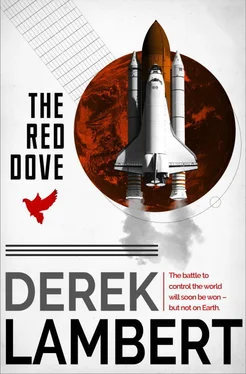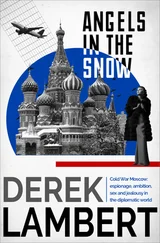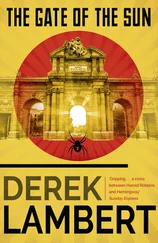The Launch Controller said: ‘And you, Oleg, have you any message?’
But, perhaps because Sedov hadn’t anyone in the world except the surrogate son now sitting beside him, no report had been made.
‘The same as Nicolay. I’m proud to be representing the Soviet people and the Party on this mission.’
Sedov took off his helmet and headset. ‘You know,’ he said to Talin, ‘I meant that. Did you?’
‘About the Russian people, yes. I didn’t mention Party.’
‘That’s the way they’ll infer it.’
‘I don’t care how they infer it,’ Talin said.
‘Is everything… all right, Nicolay?’
‘Everything’s fine,’ Talin said.
In front of them the sky was glowing cold green and the stars were withdrawing.
They returned to the check-list. Letters and figures continued their ghostly dance on the screens.
Occasionally the scientist who was investigating the harnessing of solar heat and the meteorologist asked questions.
Then they were on the brink of beyond.
Ten, nine, eight…
The countdown was followed by two heads of state.
By the President of the Soviet Union watching on television in Moscow and by the President of the United States listening on the radio in Washington where it was the early hours of the morning.
The Russian leader sat in an ornate reception room in the Kremlin; the American in his living room in the White House with his wife.
…seven, six, five…
The heads of the two biggest secret police forces in the world also waited anxiously. George Reynolds in his soulless office at Langley, Virginia; Nicolay Vlasov in his well-appointed room in Dzerzhinsky Square, Moscow.
Paradoxically, the two Americans were much more interested than their Soviet counterparts. As people are when they believe that a rival’s hour of glory may disintegrate into catastrophe.
The two Russians were more concerned with another count-down – the last hours before the previous day’s comprehensive penetration of Vandenberg took effect. The débâcle was timed for midday. After that the talons of the American Eagle would be clipped forever. What could be more interesting than that?
…four, three, two…
If anything went wrong now they would have to escape in shutes linked to bunkers 1,000 feet away.
…one, zero…
Talin thought: ‘It hasn’t snowed.’
Dove’s three main engines fired, their 1,100,000 lb thrust momentarily bending her fuselage; then resiliently she sprang back into shape.
Three seconds later, with the engines straining at 90 per cent power, the great rockets to which Dove was clamped also ignited, lending her another six million pounds thrust.
Simultaneously the shackles holding the whole shuttle – spaceship, rockets and tank – were unlocked.
It shuddered.
Talin said into the mouthpiece of his headset: ‘We have lift-off.’
A part of him saw and heard the ascent as though he were on the ground. The great tail of white-gold fire. The billowing nest of gas. The majestic climb into the pale sky. The spectators who had retreated to a stand four miles away would hear a deafening roar; a little later there would be a sonic boom.
Gently, as intended, Dove rolled on to her back as she curved upwards. For much of the mission she would stay that way without any discomfort to her passengers – free of the harness of gravity it didn’t matter which way up you were.
As the messages flickered on to the computer screens Talin glanced at Sedov; he was staring ahead and, with gravity pulling the flesh of his face backwards, there was a desolate quality there that frightened Talin. As if he knows about the decision I have to make.
Talin moved his left hand towards the computer punch-out: with the gravitational pull it felt as though it was encased in plaster.
When they were fifty seconds into their journey the main engines throttled back to 70 per cent power to cope with Max Q, the point at which maximum dynamic pressures were reached.
Upside down, Talin gazed at the mountains and plains of Kazakhstan.
Ten seconds later the engines picked up full power again.
When she had been climbing for two minutes, when her speed was four times the speed of sound, when she was thirty miles high, Dove discarded her two rocket boosters. Their parachutes opened and they began their descent to the Aral Sea.
Dove’s main engines continued to propel her upwards until, nine minutes after launch, at a height of eighty miles, they shut down, having consumed 500,000 gallons of fuel.
Explosives dispatched the external tank. Dove was alone.
Smaller engines fired. Then a last burn planted Dove into orbit travelling at 17,500 mph at an altitude of 160 miles.
The time was 10.41.
Dove, scheduled to stay in orbit for four days, was tracked at seven land bases in the Soviet Union, and at stations in Fort Lamy in Chad, Khartoum in the Sudan, Mirny in Antarctica, Camagüey in Cuba and Kerguelen in the southern reaches of the Indian Ocean. It was also followed by tracker ships sailing the oceans of the world including the Kosmonaut Yuri Gagarin which boasted 120 laboratories and 100 antennae, and could be patched through by telephone to any part of the Soviet Union via Molniya satellite links.
The West followed Dove’s progress through tracking stations strung across the United States, including Hawaii and Kodiak Island, Alaska, bases in Britain, West Germany, Guam and Australia and from tracker ships. The pride of the US observation posts was the AN/FPS-85 at Elgin Air Force Base, Florida; its radars set in a towering concrete hulk could sweep vast areas of space in a fraction of a second.
Today, 14 January, had begun like any other day in these Western stations monitoring all the satellites – and the debris orbiting the earth like riderless horses in a track race. The station duty officers were aware of the Dove launch and observed it take its place in orbit with casual interest.
Until 0300 hours Washington time when each received a coded radio message from NORAD, nerve-centre of the United States’ early warning system: BE PREPARED FOR UNSCHEDULED MANOEUVRES BY SOVIET ORBITER DOVE AND BE READY TO RENDER ASSISTANCE WHERE POSSIBLE.
Even more urgent messages were radioed to beam and missile-launching sites deployed over the United States and other NATO countries advising them NOT to react to any message mistakenly reaching them that, if the Soviet orbiter plunged towards North America instead of Asia, its intent was hostile.
George Reynolds had said: ‘We need a spectacular not a disaster movie,’ and the President had replied: ‘Holy shit, George, you had us all fooled – you have got a sense of humour.’
Puzzled unit commanders only learned much later that the warning had been deliberately delayed in case Soviet cryptoanalysts decoded the messages and warned Tyuratam to abort the launch. As it happened the Russians didn’t decode the warnings until two and a half hours after their dispatch.
At 11.45 hours Moscow time Nicolay Vlasov joined the Soviet President in the red and gold, chandelier-hung reception room in the Kremlin. Tarkovsky was there, suspended between triumph and doubt. Together the three of them walked into the marble-floored hallway and took the elevator to the briefing room in the basement.
The President sat at the head of the long, mahogany table. On his right squatted a battery of telephones, behind him two maps, one showing the deployment of United States missiles in the States and Europe, the other the location in orbit of US military satellites.
At the far end of the room stood a computer terminal. The walls were painted schoolroom-green and were bare except for the maps, a photograph of the President, a television set and portrait of Lenin. Vlasov and Tarkovsky sat opposite each other.
Читать дальше
Конец ознакомительного отрывка
Купить книгу












